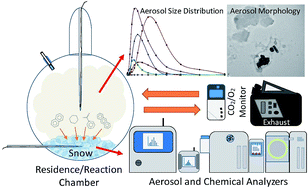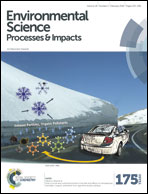Role of snow and cold environment in the fate and effects of nanoparticles and select organic pollutants from gasoline engine exhaust†
Abstract
Exposure to vehicle exhaust can drive up to 70 % of excess lifetime cancer incidences due to air pollution in urban environments. Little is known about how exhaust-derived particles and organic pollutants, implicated in adverse health effects, are affected by freezing ambient temperatures and the presence of snow. Airborne particles and (semi)volatile organic constituents in dilute exhaust were studied in a novel low-temperature environmental chamber system containing natural urban snow under controlled cold environmental conditions. The presence of snow altered the aerosol size distributions of dilute exhaust in the 10 nm to 10 μm range and decreased the number density of the nanoparticulate (<100 nm) fraction of exhaust aerosols, yet increased the 100–150 nm fraction. Upon 1 hour exhaust exposure, the total organic carbon increased in the natural snow from 0.218 ± 0.014 to 0.539 ± 0.009 mg L−1, and over 40 additional (semi)volatile organic compounds and a large number of exhaust-derived carbonaceous and likely organic particles were identified. The concentrations of benzene, toluene, ethylbenzene, and xylenes (BTEX) increased from near the detection limit to 52.48, 379.5, 242.7, and 238.1 μg kg−1 (± 10 %), respectively, indicating the absorption of exhaust-derived toxic organic compounds by snow. The alteration of exhaust aerosol size distributions at freezing temperatures and in the presence of snow, accompanied by changes of the organic pollutant content in snow, has potential to alter health effects of human exposure to vehicle exhaust.

- This article is part of the themed collection: Environmental Science: Processes & Impacts 2016 Most Downloaded Articles

 Please wait while we load your content...
Please wait while we load your content...